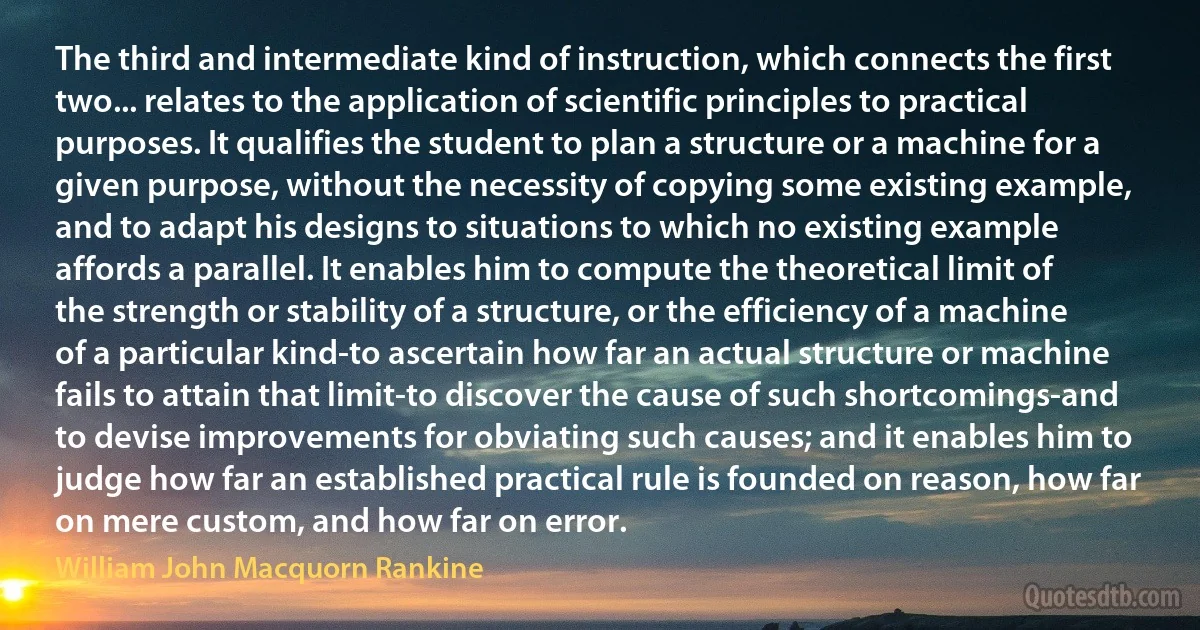
The third and intermediate kind of instruction, which connects the first two... relates to the application of scientific principles to practical purposes. It qualifies the student to plan a structure or a machine for a given purpose, without the necessity of copying some existing example, and to adapt his designs to situations to which no existing example affords a parallel. It enables him to compute the theoretical limit of the strength or stability of a structure, or the efficiency of a machine of a particular kind-to ascertain how far an actual structure or machine fails to attain that limit-to discover the cause of such shortcomings-and to devise improvements for obviating such causes; and it enables him to judge how far an established practical rule is founded on reason, how far on mere custom, and how far on error.
William John Macquorn RankineRelated topics
cause compute custom devise error example far given intermediate judge kind mere necessity parallel plan purpose reason rule stability strength thirdRelated quotes
In psychotherapy, the impact of love feelings, technically called the transference, is held under some degree of control by the artificial device of interpreting the patient's feelings while establishing barriers to the psychological exposure of the therapist. The therapist is supposed to come to the relationship fully endowed with a stable set of established insights which will be adequate in a practical sense to any application which the patient's needs will require. The patient, on the other hand, is supposed to limit his interaction with the therapist to the areas where he is aware of psychic pain or where the therapist accepts communication in the name of therapeutic technique. If everything else is carefully excluded, neither participant will be called on to deal with areas of the unknown in themselves which would require creative personal investment.

Paul Rosenfels
Few people seem to perceive fully as yet that the most far-reaching consequence of the establishment of the common origin of all species is ethical; that it logically involved a readjustment of altruistic morals, by enlarging, as a necessity of rightness, the application of what has been called the 'Golden Rule' from the area of mere mankind to that of the whole animal kingdom. Possibly Darwin himself did not quite perceive it. While man was deemed to be a creation apart from all other creations, a secondary or tertiary morality was considered good enough to practise towards the 'inferior' races; but no person who reasons nowadays can escape the trying conclusion that this is not maintainable. And though we may not at present see how the principle of equal justice all round is to be carried out in it entirety, I recognize that the League is grappling with the question.

Thomas Hardy
What we're after is to remind ourselves that we didn't come to Anarres for safety, but for freedom. If we must all agree, all work together, we're no better than a machine. If an individual can't work in solidarity with his fellows, it's his duty to work alone. His duty and his right. We have been denying people that right. We've been saying, more and more often, you must work with the others, you must accept the rule of the majority. But any rule is tyranny. The duty of the individual is to accept no rule, to be the initiator of his own acts, to be responsible. Only if he does so will the society live, and change, and adapt, and survive. We are not subjects of a State founded upon law, but members of a society founded upon revolution. Revolution is our obligation: our hope of evolution.

Ursula K. Le Guin
What the structure of Rawls's argument indicates is a more fundamental feature of his thought. This is an amphibious world, which contains just enough land of real social reference to avoid the tricky deeps of first philosophy (the gesture is roughly: let's start out from where we're at – in other words, Bush–Clinton country), while floating carefully enough on the waters of abstraction to avoid contact with the ground of actual political change (for example: what has happened in the US since the 1970s). The result is a kind of political cabotage, a critique of existing society that clings nervously to its shores. Readers of Rawls might well ask: where is the actual justice in the United States that corresponds to the ideal construct he offers us, if it is based on ‘plain truths widely accepted by citizens'?

Perry Anderson
There...is the necessity for freedom of speech and the arts. We have to scrutinize all the advances of society to judge whether they are cruel or frustrate cruelty, and for that purpose we must hear the evidence of all persons affected by their operation and of all persons qualified by experience or learning or speculative gifts to form an interesting opinion on what those operations might be. It is therefore necessary that all classes of men should be given the fullest opportunity to express themselves without constraint, not only out of admiration for an abstraction, but as a practical measure toward human survival. It is also necessary that the artist, of whatsoever kind, should be free to anatomize the spirit, so that we can comprehend the battlefield that is this life, and which are the troops of light and which of darkness, and what light may be, and darkness.

Rebecca West
